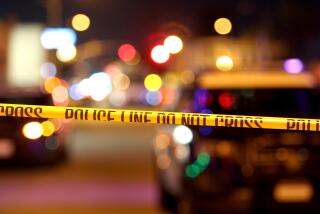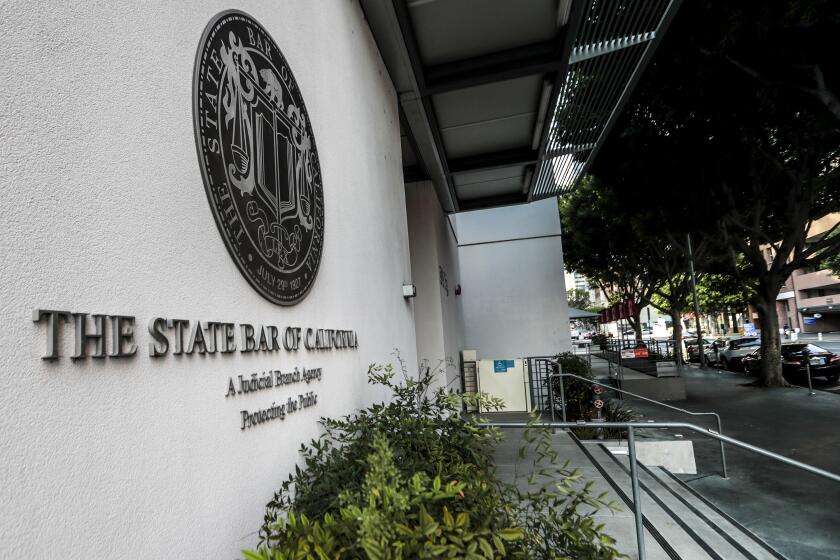Killings are down in Compton, Sheriff’s Department says
- Share via
Mary Lawson attests to just how much crime has dropped in her Compton neighborhood each evening when she and her husband go out to their front porch to sit.
For years, they avoided the porch, fearful of stray bullets and gang toughs. For the same reasons, her husband and other parents on their block insisted on driving their children to school each day.
The gunfire on New Year’s Eve used to be so bad that the Lawsons would check into a hotel that night. This year, they stayed at home.
“We heard not one gunshot,” Lawson, 67, said. “Now you don’t have to be afraid of sitting on your porch, or going to and from your car…. You just don’t have the fear there used to be before.”
Last month, Los Angeles Police Department officials celebrated continued steep drops in crime across the city. On Monday, it was the sheriff’s turn, as officials released figures showing that across Los Angeles County, homicides in regions patrolled by the Sheriff’s Department had hit the lowest rate since 1965.
Beyond the statistics, the decline in crime has changed lives in many areas that have historically been among Southern California’s most dangerous. Few have seen violence drop so far and so fast as Compton, a city long synonymous with gang violence and gangster rap.
Compton recorded 24 homicides in 2010, compared with 36 in 2009. The count is the lowest it’s been in years — and far below 1991, when the city had 87 slayings. Other types of violent crime, including assaults and rape, are also down.
Sheriff’s officials have attributed the decline to a decade-long effort to build bonds in the community in the fight against gang violence — and an infusion of extra resources when those efforts were floundering.
“This is the culmination of a long relationship,” said Capt. Diane Walker of the sheriff’s Compton station, which has patrolled the city for about a decade. “Residents aren’t just calling us for emergencies anymore. They give us tips, they help us in crime prevention.”
Cmdr. Todd Rogers said those ties have allowed deputies to focus on the “right arrests.” “Initially we had to go in there, do a lot of arrests, take guns off the street … really saturate the area, really retake the streets,” he said. “Enforcement is even more targeted now.”
The effect can readily be seen on the city’s streets, according to longtime residents.
“You see more people out and about,” said Charles Davis, who served for several decades as Compton’s city clerk. “You see a lot more people outside. There was a time when, if you had to be outside, you would be in your backyard, not your frontyard.”
Minnie Jones, 84, a Compton resident since 1951, measures the changes by walks in the park.
In the late 1990s, she was strolling to a local park with two friends one morning when three youths approached and demanded they give up their money and car keys. Her male companion’s car was stripped and her own car was later used in a robbery, she recalled.
Jones said the crime was traumatizing, but now, the park is once again hers.
“I’m over there all the time now,” Jones said. “Yes, I do feel safer.”
On Monday afternoon, Patricia Hardaway, 54, sat on a bench at Wilson Park as her granddaughter zoomed down a slide before running off with about two dozen other children. The trip, she said, would have been far less likely even two years ago. But times have changed. A security guard patrols the park, officials have installed new equipment and parents are coming en masse, watching over their children together.
“People used to come by looking for other gang members, she said. “This is where I bring my grandbabies, and I feel safe.”
Sheriff’s officials acknowledge that there’s still much work to be done in Compton. Even with the latest drop, Compton’s per capita homicide rate was still more than five times the national average. But compared to a recent peak of 65 killings in 2005, the decline is notable.
Many residents praise the Sheriff’s Department for beefing up patrols. But others see a bigger shift in the role of gangs in the city.
More than a decade ago, amid high violent crime, the city disbanded its own police force and contracted with the Sheriff’s Department. Though killings surged again a few years later, the Sheriff’s Department brought more deputies, and violence quickly began to decline. Still, some city officials want Compton to have its own force again.
Many interviewed Monday said they’re pleased with the sheriff’s work, but not all residents were ready to give the department complete credit for recent gains. Although the sheriff’s patrols played a role in pushing violence down, they say, a more profound shift in youth culture also has been at work. The lure of gang culture in a city once mentioned so commonly by gangster rappers like Dr. Dre and Eazy-E has diminished.
“People used to know us as the rap capital of the country,” said the Rev. Alejandro Leon, a Compton pastor who mentors gang members and helps turn their lives around. “We had a reputation concerning gangs. Now gangs are not as active as they were. Many of the older gang members are in prison, or they’re dead.”
Times staff writers Shan Li and Maloy Moore contributed to this report.
More to Read
Sign up for Essential California
The most important California stories and recommendations in your inbox every morning.
You may occasionally receive promotional content from the Los Angeles Times.












